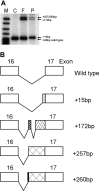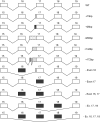A complex splicing defect associated with homozygous ankyrin-deficient hereditary spherocytosis
- PMID: 17327413
- PMCID: PMC1890827
- DOI: 10.1182/blood-2006-09-046573
A complex splicing defect associated with homozygous ankyrin-deficient hereditary spherocytosis
Abstract
Defects in erythrocyte ankyrin are the most common cause of typical, dominant hereditary spherocytosis (HS). Detection of ankyrin gene mutations has been complicated by allelic heterogeneity, large gene size, frequent de novo mutations, and associated mRNA instability. Using denaturing high-performance liquid chromatography (DHPLC)-based mutation detection, a mutation in the splice acceptor of exon 17 was discovered in a Turkish family. Reticulocyte RNA and functional minigene splicing assays in heterologous cells revealed that this mutation was associated with a complex pattern of aberrant splicing, suggesting that removal of intron 16 is important for ordered ankyrin mRNA splicing. As predicted by clinical, laboratory, and biochemical studies, the parents were heterozygous and the proband was homozygous for this mutation. These data indicate that DHPLC offers a highly sensitive, economic, and rapid method for mutation detection and, unlike previously suggested, homozygosity for a mutation associated with dominant ankyrin-linked HS may be compatible with life.
Figures


Similar articles
-
Ankyrin-linked hereditary spherocytosis in an African-American kindred.Am J Hematol. 2008 Oct;83(10):789-94. doi: 10.1002/ajh.21254. Am J Hematol. 2008. PMID: 18704959 Free PMC article.
-
Hematologically important mutations: ankyrin variants in hereditary spherocytosis.Blood Cells Mol Dis. 2005 Nov-Dec;35(3):345-7. doi: 10.1016/j.bcmd.2005.08.008. Epub 2005 Oct 11. Blood Cells Mol Dis. 2005. PMID: 16223590
-
Spectrum of Ankyrin Mutations in Hereditary Spherocytosis: A Case Report and Review of the Literature.Acta Haematol. 2018;140(2):77-86. doi: 10.1159/000492024. Epub 2018 Sep 18. Acta Haematol. 2018. PMID: 30227413
-
Hematologically important mutations: spectrin and ankyrin variants in hereditary spherocytosis.Blood Cells Mol Dis. 1998 Dec;24(4):539-43. doi: 10.1006/bcmd.1998.0217. Blood Cells Mol Dis. 1998. PMID: 9887280 Review. No abstract available.
-
Red cell membrane polypeptides under normal conditions and in genetic disorders.Transfus Clin Biol. 1995;2(4):207-16. doi: 10.1016/s1246-7820(05)80086-2. Transfus Clin Biol. 1995. PMID: 8542017 Review.
Cited by
-
Aberrant splicing contributes to severe α-spectrin-linked congenital hemolytic anemia.J Clin Invest. 2019 Apr 30;129(7):2878-2887. doi: 10.1172/JCI127195. J Clin Invest. 2019. PMID: 31038472 Free PMC article.
-
A novel splice variant in the N-propeptide of COL5A1 causes an EDS phenotype with severe kyphoscoliosis and eye involvement.PLoS One. 2011;6(5):e20121. doi: 10.1371/journal.pone.0020121. Epub 2011 May 17. PLoS One. 2011. PMID: 21611149 Free PMC article.
-
Ankyrin-linked hereditary spherocytosis in an African-American kindred.Am J Hematol. 2008 Oct;83(10):789-94. doi: 10.1002/ajh.21254. Am J Hematol. 2008. PMID: 18704959 Free PMC article.
-
Two Variants of the ANK1 Gene Associated with Hereditary Spherocytosis.Biomedicines. 2025 Jan 27;13(2):308. doi: 10.3390/biomedicines13020308. Biomedicines. 2025. PMID: 40002721 Free PMC article.
-
α-thalassaemia combined with hereditary spherocytosis in the same patient.Exp Ther Med. 2018 Feb;15(2):1298-1303. doi: 10.3892/etm.2017.5579. Epub 2017 Nov 28. Exp Ther Med. 2018. PMID: 29434716 Free PMC article.
References
-
- Eber S, Lux SE. Hereditary spherocytosis: defects in proteins that connect the membrane skeleton to the lipid bilayer. Semin Hematol. 2004;41:118–141. - PubMed
-
- Eber SW, Gonzalez JM, Lux ML, et al. Ankyrin-1 mutations are a major cause of dominant and recessive hereditary spherocytosis. Nat Genet. 1996;13:214–218. - PubMed
-
- Gallagher PG. Hematologically important mutations: ankyrin variants in hereditary spherocytosis. Blood Cells Mol Dis. 2005;35:345–347. - PubMed
-
- Duru F, Gurgey A, Ozturk G, Yorukan S, Altay C. Homozygosity for dominant form of hereditary spherocytosis. Br J Haematol. 1992;82:596–600. - PubMed
-
- Michaely P, Bennett V. The ANK repeats of erythrocyte ankyrin form two distinct but cooperative binding sites for the erythrocyte anion exchanger. J Biol Chem. 1995;270:22050–22057. - PubMed
Publication types
MeSH terms
Substances
Grants and funding
LinkOut - more resources
Full Text Sources
Research Materials

